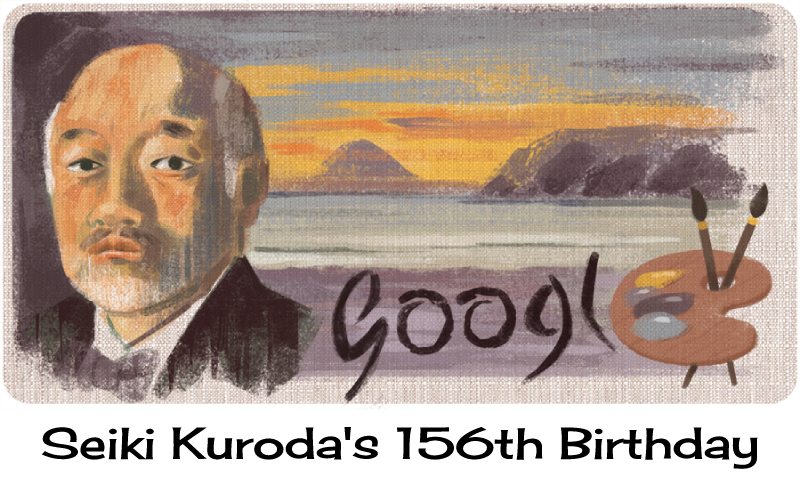
Google Doodle celebrates the 156th birthday of Japanese painter and teacher Kuroda Seiki (黒田 清輝), who is known as the father of Western-style paintings in Japan, on August 9, 2022.
Kuroda Shintarō was born on August 9, 1866, in Kagoshima, Japan where he was adopted by his uncle at birth and moved to his estate in Tokyo. He was among the leaders of the yōga (or Western-style) movement in the late nineteenth and mid-twentieth century Japanese painting, and has come to be recalled in Japan as “the father of Western-style painting.”
Upon entering the world, the boy was named Shintarō; this was changed to Seiki in 1877 when he was 11. In his early teenagers, Kuroda started to get familiar with the English language in preparation for his university studies; within two years, nonetheless, he had decided to switch to French instead. At 17, he signed up for pre-college courses in French, as preparation for his planned legal studies college.
Thus, when in 1884 Kuroda Seiki’s brother-in-law Hashiguchi Naouemon was delegated to the French Legation, it was decided that Kuroda would go with him and his wife to Paris to start his real studies of law. He arrived in Paris on March 18, 1884, and was to stay there for the next decade.
At age 18, Kuroda Seiki went to Paris to study law however rather decided to seek painting after two years. While in France, he spent a decade learning how to paint in the Western academic style, sharpening his art during a period of self-discovery.
Having spent numerous long years of study in France to acquire mastery of Western-style painting, Kuroda Seiki was anxious to evaluate his freshly discovered skills in the landscapes of his home country. Soon after arriving back in Japan, Kuroda traveled to Kyoto for the first time in his life and used plein-air methods to portray renowned local sights, like geisha and old temples. Paintings inspired by this trip incorporate Maiko (1893, Tokyo National Museum) and Talk on Ancient Romance (1898, destroyed).
In 1893, Seiki Kuroda got back to Japan and breathed fresh air into the Western-style art scene in numerous Japanese cities. He began a Western painting school called Tenshin Dojo and established pleinairism which is the act of painting outdoors. In 1986, he established the Habuka-kai — otherwise called the White Horse Society — a gathering of Japanese experts in yoga and painting. He was likewise invited to teach the Western Painting Department at the Tokyo School of Fine Arts.
In his waning years, Seiki Kuroda was picked as a teishitsu gigei-in, or Imperial Household Artist, to make works for the Tokyo Imperial Palace. He likewise served as the President of the Imperial Art Academy and was named a Viscount in 1917. Then, in 1920, Kuroda was selected to join Japan’s House of Peers, or Kizoku-in, the new aristocratic social class during the Meiji Era.
Kuroda Seiki (黒田 清輝) established a lasting impression on the art world in Japan and then some, inspiring the next generation of Western-style, Impressionist, and Pleinairist artists to proceed with his legacy. His works can be found in countless museums and galleries like the Artizon Museum in Tokyo and the Kuroda Memorial Hall within the Tokyo National Museum. Two of his works, Maiko (1893) and Lakeside (1897), have additionally been selected as commemorative postage stamps by the Japanese government.
On August 9, 2022, Google featured a Doodle on its homepage for celebrating Seiki Kuroda’s 156th Birthday. Kuroda was an influential artist who’s known as the father of Western-style paintings in Japan. He was likewise a teacher and art administrator for the Tokyo Art School, as well as the founder of the White Horse Society.
May is Small Business Month, a time to honor and recognize the achievements of the… Read More
Swiss International University (SIU) is on track to be one of the world's most respected… Read More
In a session that left students buzzing with fresh ideas and practical insights, Invertis University… Read More
At the 21st Shanghai International Automobile Industry Exhibition, which is surging with the wave of… Read More
Liverpool, UK—House of Spells and Comic Con Liverpool are once again collaborating to bring the… Read More
Introduction In India's booming EdTech space, there's one name that's making waves among Telugu students… Read More